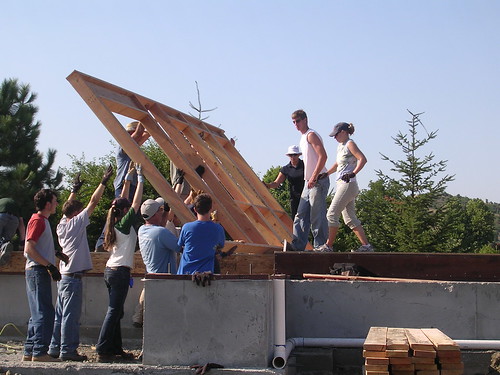New Year’s Resolutions are often made with the best of intentions and promptly dropped. Statistics show that about two weeks into the year one-third of those who make resolutions are close to quitting. By March, 85 percent will have thrown in the towel!
What better way to keep that resolution to volunteer than to reassess exactly how volunteering will benefit you? You may be surprised at some of the various benefits of volunteerism!
- Meet new people Volunteering brings together a diverse range of people from all backgrounds and walks of life. It puts you in contact with folks with similar interests that you may not have encountered otherwise! Volunteer projects are a great way to make new friends or simply meet people with different life experiences than your own. You can not only develop lifelong personal and professional relationships, you can also hear about job openings, gather insider employment information and develop great references.
-
Network and gain connections In these uncertain economic times, the opportunity to network is nothing to scoff at. Volunteer projects offer that chance, and often in an arena related to your current skills. Networking is an exciting benefit of volunteering and you can never tell who you will meet or what new information you will learn and what impact this could have on your life.

- Looks good on your resume & college application Volunteering demonstrates workplace, management, and leadership skills that can be documented in a resume. Work experience is work experience, with or without a paycheck. If you are developing new skills or thinking of pursuing a new career, volunteer work can give you valuable, practical experience. Career counselors and headhunters encourage job seekers to document pertinent volunteer experiences. Volunteer work support skills, character and balance in life. 90% of executives in a national survey of Fortune 500 companies believed volunteering built teamwork and provided valuable professional development opportunities.
- Learn new skills Volunteering is the perfect vehicle to discover something you are really good at and develop a new skill. It is never too late to learn new skills and there is no reason why you should stop adding to your knowledge just because you are in employment or have finished education. Planning and implementing a major fundraising event can develop goal setting, planning and budgeting skills. Supervising and training other volunteers helps to develop supervisory and training skills. Volunteering is the perfect way to discover something that you’re good at while contributing to the benefit of your community.
-
Gain confidence and a sense of achievement Volunteers are motivated in their work because they are able to work for a cause or passion that they truly believe in. When one is able to work for a cause close to their heart, they feel a sense of achievement at seeing the effect that their good work has on others. Volunteering around a personal interest or hobby can be fun, relaxing and energizing. That energy and sense of fulfillment can carry over to other aspects of your life and sometimes helps to relieve work tensions and foster new perspectives for old situations.

- Better your health Those who participate in volunteer activities report higher levels of life satisfaction, sense of control over life, and feeling physical and emotionally healthier. A report featured in The International Journal of Person Centered Medicine found that people who give back to others lead more happy and healthy lives than those who do not volunteer. “People in general are happier and healthier, and may even live a little longer, when they’re contributing” to their community or an organization they are passionate about, said study author Stephen G. Post, PhD. A majority of study participants said their volunteer activities enrich their sense of purpose in life and lower stress levels. The survey also showed that those who give back are less likely to feel hopeless and lonely than people who do not volunteer.
- Feel good by doing good! Volunteering is about giving your time, energy and skills freely. As a volunteer you have made a decision to help on your own accord, free from pressure to act from others. Volunteers predominantly express a sense of achievement and motivation, and this is ultimately generated from your desire and enthusiasm to help. It may be true that no one person can solve all the world’s problems, but what you can do is make that little corner of the world where you live just that little bit better!
- Establish yourself in your community We sometimes take for granted the community that we live in. It is easy to become disconnected with the issues that face your community as a whole. Why not bridge that expanding gap through volunteering? Volunteering is ultimately about helping others and having an impact on people’s wellbeing. What better way is there to connect with your community and give a little back? As a volunteer, you certainly return to society some of the benefits that society gives you.
- Find new hobbies and interests Finding new interests and hobbies through volunteering can be fun, relaxing and energizing. Sometimes a volunteer experience can lead you to something you never even thought about or help you discover a hobby or interest you were unaware of. You can strengthen your personal and professional mission and vision by exploring opportunities and expanding your horizons. Perhaps you’ll discover a previously unknown passion for education or making blankets for homeless shelters!
What are the benefits you’ve experienced through volunteering? Have you succeeded in keeping your resolutions? Let us know in the comments below.



 Volunteers benefit from volunteering, whether it’s from a closer peer-relationship with teachers and staff at the school or by building positive relationships with students. Volunteers benefit from their work with schools through:
Volunteers benefit from volunteering, whether it’s from a closer peer-relationship with teachers and staff at the school or by building positive relationships with students. Volunteers benefit from their work with schools through:

 What makes people volunteer? This question often runs across the minds of nonprofit organizations when trying to recruit volunteers for service projects. It is important to understand these motivating factors to recruit more dedicated volunteers to your cause. When individuals have a strong tie to your organization, they are more likely to return for service again. They feel that their needs and feelings are being respected when they are included in project planning.
What makes people volunteer? This question often runs across the minds of nonprofit organizations when trying to recruit volunteers for service projects. It is important to understand these motivating factors to recruit more dedicated volunteers to your cause. When individuals have a strong tie to your organization, they are more likely to return for service again. They feel that their needs and feelings are being respected when they are included in project planning. otherwise. This type of reasoning includes “I can make new contacts that might help my business or career “or “Volunteer work will look good on my resume.” It is important for your organization to include the personal benefits to volunteering, as well as the overall community benefits from volunteer work.
otherwise. This type of reasoning includes “I can make new contacts that might help my business or career “or “Volunteer work will look good on my resume.” It is important for your organization to include the personal benefits to volunteering, as well as the overall community benefits from volunteer work.
 limited to identifying the current quality and quantity of service by episodic volunteer in the last three to five years and surveys identifying areas in which episodic volunteers may be helpful.
limited to identifying the current quality and quantity of service by episodic volunteer in the last three to five years and surveys identifying areas in which episodic volunteers may be helpful. contact is the third recruiting technique. The fourth method of volunteer recruitment is the mass appeal. This includes such things as flyers, print and media ads, billboards, brochures, window displays, or want ads.
contact is the third recruiting technique. The fourth method of volunteer recruitment is the mass appeal. This includes such things as flyers, print and media ads, billboards, brochures, window displays, or want ads. Employee volunteer programs are a great way to not only benefit your community, but also your workplace environment and employees. It is easy to begin one of these programs within your office environment. By serving your community as an organization, the community will get to know your business and their employees. Establishing a personal connection with the community will improve the overall attitude that your community has toward your business.
Employee volunteer programs are a great way to not only benefit your community, but also your workplace environment and employees. It is easy to begin one of these programs within your office environment. By serving your community as an organization, the community will get to know your business and their employees. Establishing a personal connection with the community will improve the overall attitude that your community has toward your business. and the people with which it operates.
and the people with which it operates.
 they feel the issues they care about are also important to their company.
they feel the issues they care about are also important to their company.
 The weather is getting hotter and hotter, the pool is becoming less refreshing, and the kids are starting to get antsy. It’s about that time of the year again… school time! The first day of school is just days away for many kids across the country. The start of school often means stress and instant panic for parents and teachers who scramble to get last minute things together for the new school year.
The weather is getting hotter and hotter, the pool is becoming less refreshing, and the kids are starting to get antsy. It’s about that time of the year again… school time! The first day of school is just days away for many kids across the country. The start of school often means stress and instant panic for parents and teachers who scramble to get last minute things together for the new school year. field trips. Volunteering your time to chaperone or drive will ensure that your child gets an enriching and fun education!
field trips. Volunteering your time to chaperone or drive will ensure that your child gets an enriching and fun education!
 There are so many ways that you can volunteer in your community’s schools throughout the year, these are by no means your only options! Check out your local volunteer centers or speak with your school’s principal to see how your talents can be of use at your local school.
There are so many ways that you can volunteer in your community’s schools throughout the year, these are by no means your only options! Check out your local volunteer centers or speak with your school’s principal to see how your talents can be of use at your local school. As a volunteer manager, it is important to keep your volunteers up-to-date and in the loop with important information regarding your organization. Communication is also a key step to project management and it should be an essential step in every service project planning steps. What is the best communication strategy for your organization?
As a volunteer manager, it is important to keep your volunteers up-to-date and in the loop with important information regarding your organization. Communication is also a key step to project management and it should be an essential step in every service project planning steps. What is the best communication strategy for your organization? market itself at a low cost, which will help your organization attract a new audience.
market itself at a low cost, which will help your organization attract a new audience.
 is essential to the success of your project. Make sure that you make this step a priority within your organization. As you can see there are many different communication tools that your organization can use that do not cost a great deal of money. It is important for your organization to choose a communication tool that will fit your organization’s style.
is essential to the success of your project. Make sure that you make this step a priority within your organization. As you can see there are many different communication tools that your organization can use that do not cost a great deal of money. It is important for your organization to choose a communication tool that will fit your organization’s style.





